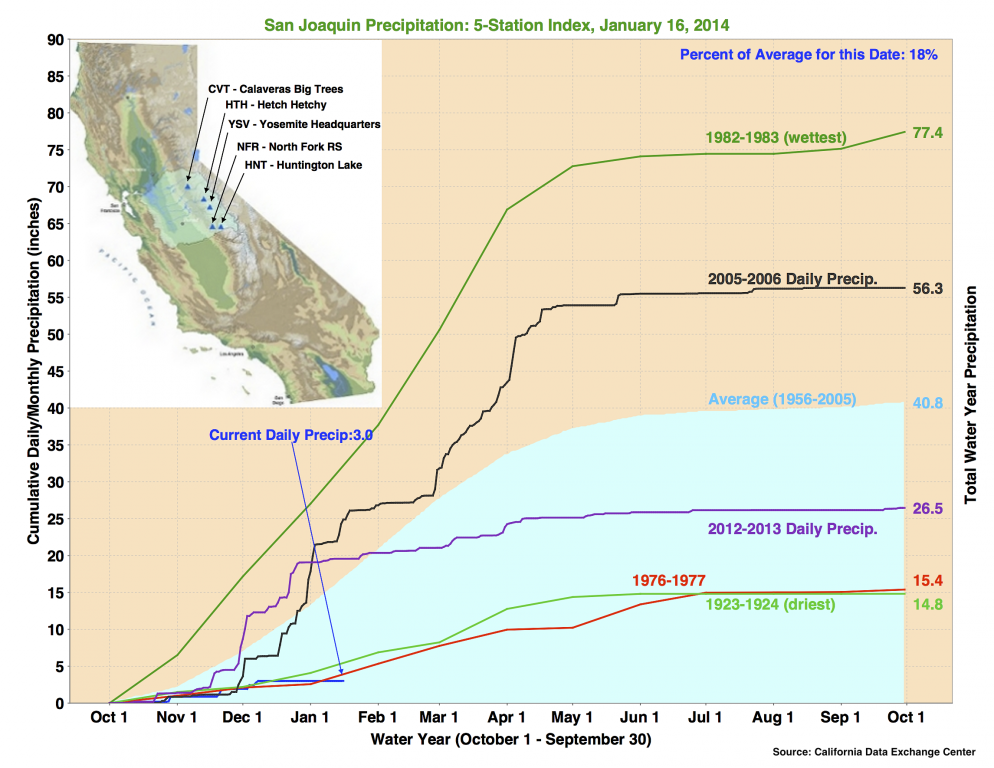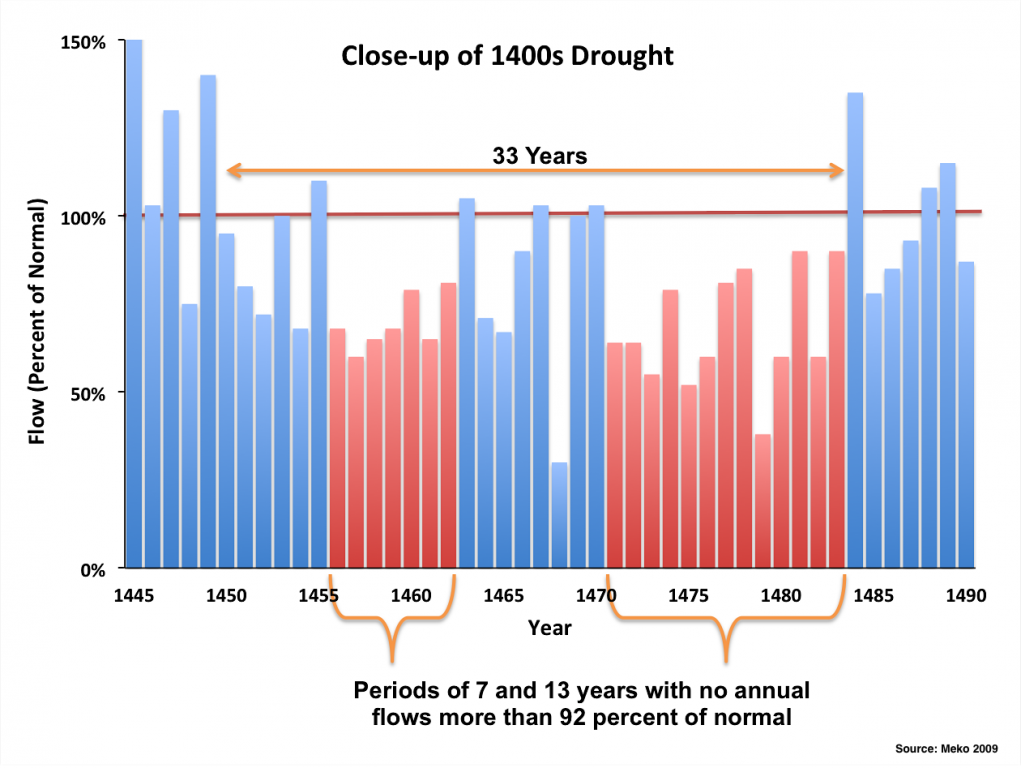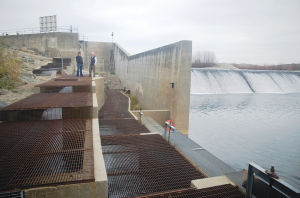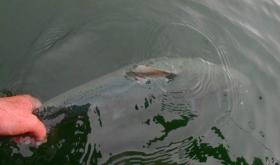|
Extreme Drought by the Numbers
|
|
|
|
January 21, 2014
As a slew of recent headlines suggests, the water supply outlook for the San Joaquin Valley and the rest of California does not look good for 2014. In light of our lack of precipitation, snowpack, and water storage, Governor Brown recently declared the drought an official state of emergency. The USDA Drought Monitor currently identifies 90% of the state in a Severe or Extreme Drought, with the worst conditions occurring in the southern Central Valley, and sure to have tremendous impacts on agriculture. Water managers around the state are scrambling to put water conservation measures in place for fear of a drought like that of 1976-77. However, some water saving measures, such as reducing the flows on the Sacramento and American Rivers, will surely have damaging effects on Central Valley salmon and steelhead.  As in the winter of 1976-77, California can attribute the current lack of precipitation to a persistent high-atmospheric pressure zone off the West Coast, stretching four miles high and 2,000 miles long, which is causing weather systems to break up or move to the north. This so-called, Ridiculously Resilient Ridge has anchored itself for 13 months, since December 2012. The 2013 calendar year will go down as the driest year on record, with some locations receiving less than 50% of the previous lowest rainfall records. For instance, Santa Cruz received only 4.78 inches compared to the old record of 11.85 inches in 1929. Even Death Valley, the driest location in the U.S., received more rain (2.17 inches) than Paso Robles (1.92 inches; avg. 12.78), King City (1.98 inches; avg. 12.06), and Hanford (1.99 inches; avg. 10.10). The San Joaquin region has currently received 18% of the average rainfall over the last three months (see graph below), and the southern Sierra is on track to receive the driest water year on record. The northern Sierra is no better off, receiving only 16% of average rainfall in the current water year, which spans October 1 st to September 30th. 
A major source of California's water is the Sierra snowpack, and as expected, the outlook is bleak. According to the Department of Water Resources snow water equivalents, the snow survey indicates 8% of normal for the Northern Sierra region, 16% of normal for the Central Sierra region, and 22% of normal for the Southern Sierra region. State wide, the average to date is 17%, and only 8% of the April 1 st average, which is generally the peak date for snowpack water content. Surface water storage is also showing the effects of the driest year on record (see below). All of the largest reservoirs that we rely on for year-round water supply are substantially lower than average. Both Shasta Lake and Lake Oroville, the two largest reservoirs in California, are at 36% of capacity, and 55% of their historical averages. Some water districts are in worse shape than others: Folsom Lake on the American River is at a mere 34% of average, while New Melones and Don Pedro are faring better at 77% of average.  With a lack of foreseeable precipitation, water managers are particularly concerned about the possibility of additional years of extreme drought. Looking back at historical flow patterns helps us understand the potential magnitude and duration of modern droughts, but our records of measured precipitation and river flows only go back about a hundred years, just a snapshot in time. The study of dendrochronology uses tree rings of long-lived tree species to construct climate patterns from the past, and can help us understand the frequency of climatic events over longer periods of history. This tree-ring data can also be correlated to stream flows to construct flow models that date back centuries, such as a reconstruction of combined Sacramento and San Joaquin annual runoff over the past 1,000 years ( Meko 2009). While many in the media have highlighted the extreme drought of 1976-77, when the measured flow in the Sacramento and San Joaquin combined was only a quarter of the mean flow, the tree-ring data reveal that extreme droughts with even lower flows have occurred at least seven times dating back to 942 AD. The driest year occurred in 1580, when the flow was only 8% of the mean.  Perhaps most concerning in the historical drought data (graph above) is a period of 33 years in the 1400s without any flow more than a few percent above the long-term mean, and 7- and 13-year timespans within that period with no flows exceeding 92% of the long-term mean. Fortunately, consecutive extreme droughts such as these have only occurred 5 times over the last 2 millennia ( Hughes and Brown 1992). Although these data put our current dry spell in some historical context, they may be small comfort for those already feeling the pinch of water shortages today. |
|
 |
|
Recent Blog Posts
|
Broadcasting the future
 Habitat restoration is no small feat: it requires years of monitoring and constant effort to repair and maintain a healthy restored habitat. Monitoring the performance of a restored area not only includes sampling for macroinvertebrates (see Focus on fish food) and assessing salmonid populations (see Who's at home?), but propagating vegetation as well. Vegetation survival is important to the growth and survival of reintroduced native wildlife in turn, since native plant species help provide appropriate habitat for both riverine and terrestrial animals. The species reintroduced to the Honolulu Bar restoration site shown above are typically found in riparian habitats occurring throughout the Central Valley. The FISHBIO technician seen above is broadcasting a mix of seeds native to Californian riparian habitats. This mix of western goldenrod, evening primrose, gumplant, and others will play an important role in establishing an effective ground cover to keep invasive species from overtaking the area. In addition to the scattered seeds, plugs of creeping rush and Santa Barbara sedge were planted intermittently throughout the floodplain. The seeds and cuttings lay the groundwork for an appropriate vegetation structure that provides food and cover for terrestrial species, and helps protect the floodplain from excess erosion and changes to its physical characteristics.  During the floodplain reconstruction, several types of common invasive plant species were removed (see On the (invasive species) battlefield). The Tree-of-Heaven ( Ailanthus altissima) is an invasive commonly found near California waterways. It can change streambed ecology by forming dense thickets that crowd out native plants, alter physical habitat, and produce chemicals that prevent other plants from taking root nearby. Established trees can be incredibly difficult to remove, as they can reproduce by sending out shoots or re-sprouting from root fragments left in the soil. The Himalayan blackberry ( Rubus discolor) is another common riparian intruder that is highly competitive and rapidly displaces native plant species. Blackberry thickets can become so dense that they block terrestrial animals' access to the water, and the lack of light can severely inhibit the growth of ground cover species. These invasive plants, among others, display highly aggressive growth and reproduction rates. The most effective way to combat these common intruders is to prevent their introduction in the first place, such as avoiding their use in landscaping. When choosing ornamental species for your home garden, it's worth noting that there are many beautiful plants native to California to choose from. Read more>
|
|
|
|
IN THE NEWS: Recent stories you might have missed...
|
California drought emergency declared by Gov. Jerry BrownSan Jose Mercury News
 Gov. Jerry Brown on Friday officially declared that California is in a drought emergency, as the state struggled with the least amount of rainfall in its 153-year history, reservoirs were at low levels and firefighters remained on high alert. "We are in an unprecedented, very serious situation," Brown said. The governor asked California residents and businesses to voluntarily reduce their water consumption by 20 percent... Read more > Gov. Jerry Brown on Friday officially declared that California is in a drought emergency, as the state struggled with the least amount of rainfall in its 153-year history, reservoirs were at low levels and firefighters remained on high alert. "We are in an unprecedented, very serious situation," Brown said. The governor asked California residents and businesses to voluntarily reduce their water consumption by 20 percent... Read more >
|
River water diversions threaten green sturgeon, study shows
Phys
 Researchers at the University of California, Davis, have used laboratory studies to estimate the risk to young green sturgeon, which may be killed by unscreened pipes that divert water from the Sacramento River into adjacent farm fields. The study confirms that this ancient protected fish species may be jeopardized by the current system of water diversion pipes. The findings also suggest that the threat could be lessened by diverting river water more slowly and over longer periods of time,... Read more >
|
Studying salmon: Numbers are up, but the population is fragile
Appeal-Democrat

Boil down the 2013 salmon year in the Yuba River: Numbers were up. Good news, right? Not so fast. It turns out bigger numbers don't always equal a healthier population. Dig deeper into those numbers and a whole world is revealed. A world where the salmon population is fragile, genetically weak, increasingly unable to adapt to fluctuations in ecosystems ravaged by climate change, where their very ability to survive is being imperiled in the time they need it most... Read more >
|
Oregon proposes removing hatchery fish from wild fish areas
Jefferson Public Radio

Hatchery-reared fish would get the heave ho from certain rivers along the Oregon Coast under the latest strategy to help Oregon's wild salmon and steelhead. The new management plan proposed by the Oregon Department of Fish and Wildlife would designate several coastal rivers as "wild fish emphasis areas," while increasing the number of hatchery fish planted in other coastal rivers to expand fishing opportunities in those waters... Read more >
|
Herring season booming in the Bay
KTVU

Herring boats stretched across the Bay near the San Rafael Bridge Friday morning, the scene attracted thousands of birds and even some seals got into the act, diving and jumping to catch a fish. People watched from the shore and commented on how many fish there were. "I've never seen that many out here before," said Brian Costello of San Rafael. Spawning season has arrived and many fishermen say this is shaping up to be a very good season... Read more >
|
|
|
|
|
|